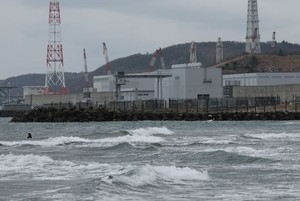Vox Populi, Vox Dei is a daily column that runs on Page 1 of The Asahi Shimbun.
August 9, 2023 at 12:52 JST
 Bouquets of flowers are placed before the monument in memory of foreign soldiers detained at the Fukuoka POW camp’s 14th branch in Nagasaki on May 13. (Asahi Shimbun file photo)
Bouquets of flowers are placed before the monument in memory of foreign soldiers detained at the Fukuoka POW camp’s 14th branch in Nagasaki on May 13. (Asahi Shimbun file photo)
A palm-size white stone bore an inscription in black that read, “I am Dick Heijn. 1912-1945.”
In May this year, a ceremony was held in front of the Nagasaki Atomic Bomb Museum to unveil a monument dedicated to foreign prisoners of war in Japan during World War II. The words “peace,” “friendship” and “freedom” were etched on the monument.
The small stone was placed atop the monument, almost buried under bouquets of flowers.
It was laid there by Annette Speijers, a 57-year-old Dutch citizen and granddaughter of Heijn.
Heijn was working in the then-Dutch colony of Indonesia during World War II when he was called up for service. He ended up a prisoner of the Imperial Japanese Army.
He was eventually sent to the Fukuoka POW camp’s 14th branch in Nagasaki and died of pneumonia five months before the war ended.
His daughter, Speijers' mother, is 86 now and still well. But, as she did not feel up to traveling to Japan in May, she asked her daughter to place a stone bearing her father’s name on the memorial in Nagasaki.
The branch camp was located 1.7 kilometers from ground zero. When the atomic bomb was dropped, the camp had about 200 prisoners, eight of whom were killed.
By the end of the war, the camp had lost more than 100 inmates to dysentery, pneumonia and other diseases.
Around the 70th anniversary of the end of the war, the deceased POWs’ families called for the construction of a monument to remember them by.
Masao Tomonaga, 80, who coordinated the project in Japan, was a 2-year-old toddler when he became a hibakusha.
The atomic bomb made no distinction between friend and foe, killing and injuring anyone who happened to be there. Seeing the monument decorated with “orizuru” paper cranes, Tomonaga renewed his conviction that all nuclear weapons must be eliminated.
From ancient times, people have laid stones in mountains and at graves. Those in mountains serve as signposts while stones at graves serve as symbols of prayer and solidarity.
The stone that was placed atop the monument in Nagasaki this year represented 78 years’ worth of thoughts and prayers.
--The Asahi Shimbun, Aug. 9
* * *
Vox Populi, Vox Dei is a popular daily column that takes up a wide range of topics, including culture, arts and social trends and developments. Written by veteran Asahi Shimbun writers, the column provides useful perspectives on and insights into contemporary Japan and its culture.




















A peek through the music industry’s curtain at the producers who harnessed social media to help their idols go global.
A series based on diplomatic documents declassified by Japan’s Foreign Ministry
Here is a collection of first-hand accounts by “hibakusha” atomic bomb survivors.
Cooking experts, chefs and others involved in the field of food introduce their special recipes intertwined with their paths in life.
A series about Japanese-Americans and their memories of World War II